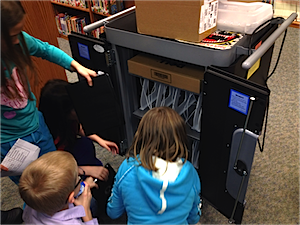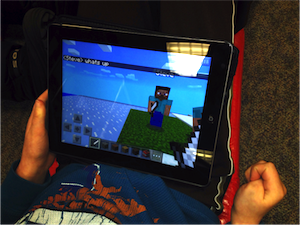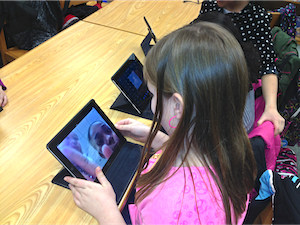When principal Matt Renwick mentioned “Minecraft” in a flyer about an afterschool computer club, 30 percent of his elementary students showed up. In his first reflection on this passion-based learning experience, Renwick considered his kids’ high engagement through Dan Pink’s three lenses: autonomy, purpose & mastery. Here he digs deeper into what educators mean when they talk about passion – and where frustration comes in. (Here are the links to this eight-part series: Part 1, Part 2, Part 3, Part 4, Part 5, Part 6 and Part 7 and Part 8.)
 After our first day, it was apparent that Minecraft was the main draw to our after-school enrichment club. But this digital tool wasn’t the only game in town. Several students expressed interest in drawing; others wanted to know how to share their writing online.
After our first day, it was apparent that Minecraft was the main draw to our after-school enrichment club. But this digital tool wasn’t the only game in town. Several students expressed interest in drawing; others wanted to know how to share their writing online.
With these interests in mind, we ordered copies of Minecraft Pocket Edition for our 20 iPads. For the other 30 iMacs, several activities were suggested, such as learning sign language via YouTube and trying out Build with Chrome, a possible Minecraft alternative.
One thing I’m learning quickly: access alone is not enough. When handed technology with little guidance or supervision, students tend to use it at the lowest common denominator, cognitively speaking. Maybe this tendency was related to the fact that my observations took place in school, where expected outcomes are, well, expected. Would posting goals that connected their interests and relevant projects to specific digital tools be the answer to unleashing the students’ passions?
They were run-walking
Reflecting on our second day, I guess the “unleashing” depends on your point of view. From our teacher perspective, the students were not lacking in passion.

Picking out an iPad
When we released half the students to the lab after a brief discussion of our routines, they did that “run-walk” you usually see reserved for recess — fearing there wouldn’t be enough computers. The other half eagerly waited for their table to be dismissed so they could select an iPad.
In an 2013 article here at the Voices blog, “The Science of Passion-Based Learning,” Peter Skillen describes passion as more than just engagement and motivation. He sees passion as an emotion that, when dovetailed with meaningful work, can lead to deep and conceptual levels of learning. “There are cognitive processes in the brain that are “turned on” by emotion,” he wrote, “be that passion, anger, anxiety or other emotions.”
Those possibilities were exciting to us. Tapping into what students were passionate about, like Minecraft and iPads, could lead to learning that might be unattainable in a more traditional school environment. And the research he cited to support this concept helped validate our efforts. As Peter describes:
“When students are passionately engaged in their learning – when they are mesmerized by their learning environment or activities – there are myriad responses in their brains making connections and building schema that simply would not occur without that passion or emotion.”
Passion meets frustration
The brain phenomenon Peter described does not necessarily guarantee a smooth start to the journey, however. For some of our students, their passion quickly turned to frustration.

Who’s got the TNT?
Google Chrome’s update wasn’t working properly — and Build with Chrome along with it. Students who previously weren’t interested in Minecraft but now saw their friends immersed in the game, all of a sudden wanted to get in on the fun. Among those already playing Minecraft, some students were not being as “cooperative” as they could have been, planting TNT (the boys) in shelters other players (the girls) were trying to build.
Side stepping our normal roles as teachers, my colleague and I tried to guide our frustrated learners to solve these problems themselves.
– For the students who were experiencing Chrome difficulties, they were encouraged to make sure every computer had the same issues (they didn’t; some worked). One student did find a computer that was working properly and start playing Build with Chrome.
– Instead of exerting our teacher/adult authority to “solve” the Minecraft cooperation problem, we invited the students involved to work it out among themselves, with our mild guidance. A couple of students used two of the iPads to have a Skype chat, sitting just 10 feet away from each other. Rather than being the experts in the room, we attempted to build expertise among the learners.
Mr. Renwick’s wild ride

Short-distance skyping
So our second day of Computer Club was something of a wild up-and-down ride. There seems to be a fine line between passion and frustration. But if we are experiencing emotions in our endeavors, that should say something about the learning climate we are participating in. It means we care deeply about the process and the outcomes.
These activities that we are engaged in matter to the students. That makes the activities important. If we can harness these passions toward building our collective intelligence, I cannot imagine a more powerful learning experience.
More to come!
Matt Renwick
Latest posts by Matt Renwick (see all)
- How Do Digital Portfolios Help Students Learn? - August 1, 2014
- Should We Unconnect from Our PLNs Over Summer Break? - July 3, 2014
- Passion-Based Learning, Week 8: The End of the Beginning - April 30, 2014


I’m sorry, but you took kids and taught / allowed them to play a computer game. OK, whatever. You were upset when the boys identified a mechanism to bother / destroy what the girls were doing, which was part of the game, but wasn’t appreciated by the girls. You don’t say what was done to prevent the boys from continuing to bother the girls. I’m going to guess you didn’t mention / identify that the girls could cooperatively build guns and shoot the boys trying to mine their houses.
I’m a great believer in computer games and having kids play them with the intent of figuring out how they work. If you’re going to let them play on a cooperative map with pvp actions engaged, then you should let that go. Dying/destruction is part of that model. Encouraging a cooperative defense would possibly have led to an interesting ending.
Mike, I appreciate you noticing the gender differences in how the kids interacted online. It is not a generalization on my part, but simply what I observed during our first day trying out Minecraft.
You said: “You were upset”. This was not the case. In fact, I anticipated that something like this might happen. When anyone, youth or adult, interacts online with others, I have found that there can be a decrease in the level of respectful discourse between the two parties. We aren’t face-to-face, which may give us the gumption to say more than maybe what we intended or meant. The point I tried to make in this post was that we were not discourage in what happened, but saw this as an opportunity to help our students be advocates for themselves.
And therein is the question. You did not elaborate in how you helped the students by advocates. What did you tell the kids that changed the behavior?
Mike, I didn’t tell them anything. I asked them to consider the situation and problem solve with the other party. They probably get tired of adults telling them what to do and think all the time.
I teach at a high that has been chosen as the pilot program for going fully digital. all of our students have been issued macbook air laptops. I have 4 classes of Alg 1 Intensive math and i am looking for some creative things to do on the computers. Student engagement, problem solving, and learning social skills is my idea of a great lesson.